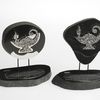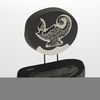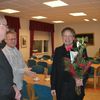Fréttir berast nú af góđum árangri í byltingarkenndri tilraun bandaríska fyrirtćkisins Neurotech, sem ég hef áđur fjallađ um, í ađ ţróa međferđ gegn ellihrörnun í augnbotnum (Dry AMD). Ţessi sjúkdómur er algengasta orsök blindu í hinum ţróađri hluta heimsins. Niđurstađa tilraunarinnar virđist gefa tilefni til bjartsýni um ađ ţróa megi međgerđ viđ sjúkdómi sem ekki hefur veriđ til međferđ viđ fram til ţessa. Ellihrörnun í augnbotnum (Dry AMD) leiđir oft til blindu eđa mjög alvarlegrar sjónskerđingar hjá eldra fólki. Sjá frekar hér fyrir neđan:
BREAKING NEWS — Emerging Treatment Stabilizes Vision in People with Dry AMD
Owings Mills, MD - March 26, 2009— An innovative technology, employing a tiny capsule implanted in the eye, is stabilizing vision in people suffering from dry age-related macular degeneration (AMD). Encapsulated Cell Technology (ECT), developed by Rhode Island-based Neurotech, preserved vision in a majority of the 51 people who participated in a Phase II clinical trial. For more information on these clinical trial results, see Neurotech’s March 26, 2009 press release. |
Flokkur: Stjórnmál og samfélag | Facebook

 einarlee
einarlee
 sjos
sjos
 gislihelgason
gislihelgason
 thjalfi
thjalfi
 gummigisla
gummigisla
 gunnimar
gunnimar
 hrannarb
hrannarb
 nonniblogg
nonniblogg
 kristinnjon
kristinnjon
 andmenning
andmenning
 retinita
retinita
 meistarinn
meistarinn
 leifurl
leifurl
 sjonni-boy
sjonni-boy





Bćta viđ athugasemd [Innskráning]
Ekki er lengur hćgt ađ skrifa athugasemdir viđ fćrsluna, ţar sem tímamörk á athugasemdir eru liđin.